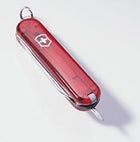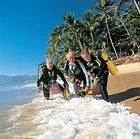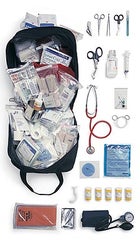MONTE LEÓN, a 243-square-mile former sheep ranch on the southern coast of Argentina, is Patagonia at its most barren, exotic, and mythically sublime. The click and roll of its beach pebbles greeted Ferdinand Magellan in 1520, when he first hit South America during his voyage around the world. The irresistible emptiness of the plains beyond haunted Charles Darwin more fiercely than anything else he saw on his 1830s cruise aboard the Beagle. And it was here in 1905 that Butch Cassidy and the Sundance Kid rode into the town of Río Gallegos and stole all the loot in the bank.
 Patagonia’s big acre: the coastline of Monte León
Patagonia’s big acre: the coastline of Monte León

 Wetsuit vigilantes (from left): Neville Walters, Daniel Hill, and Dean Kusnezow
Wetsuit vigilantes (from left): Neville Walters, Daniel Hill, and Dean Kusnezow
 The Kilimanjaro (0) is packed with plenty of what you’d expect in a backcountry medical kit—moleskin, bandages, Band-Aids, ibuprofen,—and a whole lot that’s not so common. For information call 800-858-7430;
The Kilimanjaro (0) is packed with plenty of what you’d expect in a backcountry medical kit—moleskin, bandages, Band-Aids, ibuprofen,—and a whole lot that’s not so common. For information call 800-858-7430;  Devil inside: A free spirit guns for Olympic glory.
Devil inside: A free spirit guns for Olympic glory.
Today, the region is playing host to another pair of barnstorming gringos. Last May, Doug Tompkins, the reclusive founder of both The North Face and Esprit de Corps, and his wife Kristine McDivitt Tompkins, former CEO of Patagonia Inc., negotiated to purchase this oceanfront parcel, roughly the size of Utah’s Zion National Park, for $1.7 million—all with an eye toward locking it down forever as a nature preserve that will be managed by the Argentine government. Though it may take three years before Estancia Monte León is inaugurated as the nation’s first coastal national park, the area begins welcoming visitors this month. Backpackers, bird watchers, and wilderness fans will gain access to some of the most pristine terrain in South America, home to herds of rheas and guanacos, migrating orcas, imperial cormorants, and rookeries of Magellanic penguins.
Among excitable environmentalists, this is a moment that calls for hyperventilating into an acid-free, recycled paper bag. “It’s the foundation for what could be one of the most important conservation efforts in Argentina since the park system was created in 1922,” says Guillermo Harris, a South American coordinator for the New York-based Wildlife Conservation Society. “As a philanthropic gesture, the only comparison is to what the Rockefellers did in the Tetons almost 80 years ago.” Monte León, however, is only part of the pair’s grandiose scheme. Through the newly minted Patagonia Land Trust, a nonprofit group based in Ojai, California, Tompkins, 58, and McDivitt Tompkins, 51, hope to raise an additional $10 million to pay for another three parks in Santa Cruz, the southernmost province on the Argentine mainland. In the end, they intend to set aside 300,000 acres of steppe land and coast—an area twice the size of Singapore. (According to the PLT, less than 5 percent of Patagonia is now protected against development.)
For Doug Tompkins, a Deep Ecology devotee whose ideological paternalism has backfired in the past, Monte León has come to symbolize something more than conservation. Tompkins is famous for his big pockets and sometimes overbearing style—his 1992 Christmas card included a manifesto for saving the natural world from annihilation—but the Argentine venture is a real-world metaphor for coming to grips with the notion that if you want to be a titan of preservation, savvy politics and smart PR sometimes count more than cold cash.
Tompkins’s tutorial began not in Argentina, but across the Andes in Chile, where he and his wife have invested more than $55 million in nearly a dozen separate land deals, mostly with absentee European owners, to create the world’s largest private nature reserve, a giant enclave called Pumalín Park that’s pocked with fjords and carpeted in 3,000-year-old forests (see “Lord of All He Surveys,” June 1998). But Pumalín has been a bumpy project. Within a few years of arriving, Tompkins was essentially at war with the locals, suing salmon farmers for dumping trash and raising the hackles of loggers who feared he would destroy their livelihood. His mission wasn’t helped by the Chilean military’s concern over the fact that the final piece of land needed to unite the two halves of Pumalín would effectively cut the country in two.
Confounded by the Chileans’ refusal to embrace him as an environmental messiah, Tompkins blamed his problems on xenophobic politicians and developers, who, he gripes today, sought to derail his plans through “a lot of political harassment and antagonism.” He’s mostly right—but he also must shoulder some blame. Having initially isolated himself at his lodge in Pumalín without phone or fax lines, he inadvertently cut himself off from local greens, and ignored increasingly absurd rumors that painted him as a CIA spy and head of a sylvan homeland for Jews. “At first, he didn’t really consult the local NGO community, so a lot of us didn’t know what to believe,” says Manuel Baquedano, president of Santiago’s Institute for Political Ecology.
This lack of outreach seems especially ironic for a former executive who understands how important image and perception can be. And in the end, it may have cost him. In 1997, his purchase of Pumalín’s final parcel was blocked by the Chilean government; several months later, it was secretly sold to ENDESA, the nation’s biggest energy company. End result: Tompkins still has not achieved his dream of an unbroken preserve stretching from the Pacific to the Andes.
With Monte León, Tompkins and his wife have altered their MO. Instead of covertly jigsawing together their holdings, they openly selected land already targeted for preservation. (For years, Argentine park officials had been trying to purchase the sheep ranch, but were unable to meet the asking price.) While closing the deal, the couple invited the Fundación Vida Silvestre Argentina, a local affiliate of the World Wildlife Fund, to manage Monte León and oversee its transfer to the park service. They also began buttering up Argentine movers and shakers, such as President Fernando de la Rua, who could serve as key allies—making overtures that were well received in a nation that is more cosmopolitan than Chile and, thanks to a crippling recession, is desperate for cash. “Certainly Doug and Kristine learned a lot of lessons in Chile—they’d be idiots not to have done so,” says a source close to the PLT. “But they were also helped by the fact that Argentina offers a much different climate in which to do this kind of work.”
Finally, Tompkins officially turned over the reins to his wife, who has played a crucial role by encouraging her firebrand husband to soften his style, and who appears to possess a flair for diplomacy that he may still lack. These skills will be essential as McDivitt Tompkins, in her job as chairman of the PLT, spearheads fundraising for future land purchases and parks development. To assist in the effort, her former employer is kicking in $100,000 worth of support, the first direct philanthropic gesture that Patagonia-the-company has made to Patagonia-the-place. “The truth is, we never got around to saying thanks,” says owner Yvon Chouinard, a longtime friend of the Tompkinses. “We just used the name and that was it.”
As for Doug Tompkins, despite his new, gentler style of dealmaking, he left several participants in the negotiations leading up to the Monte León deal with vivid memories of a man with an unshakable sense of mission—and a man reluctant to cede control to others. “We had heated conversations that lasted hours,” says one Argentine environmental official. “I told him we weren’t a banana republic and that he wouldn’t earn trust if he didn’t compromise.” In the end, by all accounts, he did. And as a result, the Patagonian enterprise is already evoking a response that Tompkins must surely find refreshing—gratitude. “Doug’s a gringo loco, and he’s giving us a real kick in the ass,” laughs Daniel Somma, conservation director at Argentina’s National Parks Administration. “But the truth is, we needed one.”
Gear: Palm addicts no longer have to rely on the toothpick-thin, oops-I-dropped-it-in-a-crevasse stylus provided with most handheld computers. Swiss Army’s new Stylus Knife comes equipped with a knife, scissors, and a retractable plastic tool for high-tech trailside note taking. $20; 800-442-2706;
Web site: Stop keeping track of your summits on the back of a paper bag and go digital with ePeak Register, a Web-based service that invites you to keep personalized lists of the peaks you’ve bagged. You might just find you’ve made a first ascent.
Guide: Fifty Favorite Climbs: The Ultimate North American Trek List maps the all-time favorite routes of Conrad Anker, Chris Sharma, Lynn Hill, Mark Twight, and 46 other world-class climbers. The new bookincludes topo maps and the behind-the-scenes story of how each route came to be dearly beloved. $33; 800-553-4453;
Gear: Tired of getting blisters from rental skates? Add the CCM Highlander to your ice chest. With a cush brushed-velvet lining and rugged nubuck upper, this new recreational skate is just the thing for a set of donkey laps around the local rink or a pickup game of pond hockey. $100; 800-451-4600;
TWO HOURS into his shift whacking some of the most colorful creatures to adorn Australia’s Great Barrier Reef, Daniel Hill bobs to the surface with a five-quart jug of toxic sodium bisulfate solution strapped on his back. He’s brandishing a two-foot-long injection gun that looks like it’s straight out of the Orkin arsenal, and—unlike most exterminators—he sounds downright thrilled about his workplace conditions: “Not a bad office, is it, mate?”
Hill is an underwater pest-control specialist whose prey is the crown-of-thorns starfish, or COTS, a species that in many places is a benign aquatic ornament notable mainly for its oversupply of arms (18 on average) and vibrant orange and pink hues. But the COTS feeds on living coral, and here on the world’s most famous tropical reef, it’s become a major scourge—each voracious specimen can chew through coral at a rate of 65 square feet a year. In a healthy marine ecosystem, that’s fine; COTS help keep coral growth in check. But in recent years, the Australian beasties have multiplied so fast that tens of thousands now carpet 65 percent of the middle section of the reef, a swath totaling 500 square miles.
Scientists can’t seem to agree why. Some say the explosion is part of a natural cycle; others cite agricultural runoff, which serves as COTS Viagra; and others blame overfishing of natural predators like shrimp. But the result is indisputable: “It’s the underwater equivalent of a bushfire,” says Udo Engelhardt, director of Reef Care International, which monitors COTS outbreaks.
In response to this spiny menace, at least one outfitter in the $1-billion-a-year tour-ism industry is fighting back, by hiring Hill and his scuba divers at Coral Reef Care, a group of marine mercenaries who like to call themselves “starfish troopers.” For $140 a day each, Hill’s divers swim around a tourist pontoon owned by Cairns-based Great ���ϳԹ���s, jab their probes into any COTS they come across (as many as 150 a day), and pump them chock-full of poison. Now, thanks to a recent $512,000 government subsidy, scores of starfish troopers could descend on the reef. This sounds like an awfully unneighborly way to treat starfish, but as far as the dive outfitters are concerned, it’s war out there.
“If we don’t do more right now, COTS will wipe out a lot of good diving areas,” says Col McKenzie, spokesman for the dive operators. “We’re fighting a locust plague with a butterfly net.”
First it was recycled pop bottles, now it’s leftovers from the Jolly Green Giant. In the never-ending quest to be more enviro-friendly than thou, Minnetonka, Minnesota-based fiber company Cargill Dow has figured out how to extract sugars from corn and spin them into warm, worthy fleece.
At first glance, it’s hard not to love the stuff. Cargill Dow claims its new NatureWorks fiber is just as comfy and affordable as old-fashioned fuzz. Plus, independent studies have found it wicks better than other performance polyesters, and retains one-quarter less BO. And, unlike synthetic fleece, NatureWorks is biodegradable. Bored with last season’s jacket? Just toss it on your compost pile. All this from a process that Cargill Dow says uses up to 50 percent less oil than regular poly—a fact that last year prompted the UK office of Greenpeace to release an oblique product endorsement.
But wait, there’s controversy! Greenpeace recently chalked its endorsement up to a misunderstanding—it turns out much of the corn in question was genetically engineered, and the group doesn’t support any products made with GE foods. “Kellogg’s is making Frankenfood,” cracks Greenpeace spokesman Craig Culp, “and now Cargill Dow is making Frankenfleece.” Outdoor apparel makers don’t seem so sure either. This month, Cargill Dow will finish work on a Nebraska factory capable of producing 300 million pounds of cornified fleece a year, but at press time it had yet to receive its first order.
Still, since the stuff is made from corn, we couldn’t help but wonder: If you were stuck on El Cap waiting out a storm, could you smear your sleeve with a little butter for an emergency snack? Vicki Bousman, a fleece maven at Cargill Dow says…maybe.
“But I wouldn’t recommend it.”
REMEMBER WHEN an overseas traveler’s most serious medical problem was a bad case of Delhi Belly? Those days are over. Anyone venturing onto an East African game reserve this winter faces a surge in unsavory diseases like dengue fever, malaria, and sleeping sickness–just a few reasons why today’s intrepid adventurer requires some serious pharmacological firepower.
That’s where the new supercharged, destination-specific med kits like the Kilimanjaro (below) come in. These mobile trauma centers are packed with everything from scalpels and forceps to surgical staplers and, most important, a dispensary of prescription drugs tailored to the bugs in whatever part of the world you enter. The kits weigh up to 18 pounds and cost as much as $650, but folks in the field think they’re worth it. “Prescription drugs can save hundreds of people in the backcountry,” says high-altitude physician Peter Hackett. “Everyone needs to carry a couple.”
What To Bring
- surgical stapler
- forceps
- tweezers
- scissors
- scalpel
- large shears
- sterile saline
- irrigating syringe
- stethoscope
- emergency dental module
- wire saw
- Spenco 2nd Skin
- cold compress
- airway
- prescription drugs
- SAM splint
- emergency blanket
- sphygmomanometer (blood-pressure gauge)
Age: 22. Hometown: Vail, Colorado. Age she started racing: 11. Rank in World Cup Slalom: 11. Top finishes: slalom champ at the 2001 U.S. Nationals; second this past December at a World Cup event in Sestrieres, Italy. Why she’s feeling cocky about this month’s 2002 Winter Olympics qualifier in Loveland, Colorado: “When I see familiar faces, I’m relaxed and want to show ’em what I can do.” One measure of her youthful exuberance: posed topless two years ago for the newspaper. Another: suffered a third-degree concussion last winter after attempting a 360 off a tabletop at California’s Mammoth ski resort. Out cold for: two minutes. Signs of looming maturity: She’s agreed to forgo riding her Harley Sportster until after the Olympics. How race organizer John Dakin explains her wild streak: “She has a devilish quality that comes from being a ski-resort kid.” Reason she refused to attend the U.S. Ski Team’s required dry-land training last summer, which includes weight lifting and speed drills: She prefers running, biking, swimming, waterskiing, playing squash, and bouncing on a trampoline at her father’s summer trailer near Minnesota’s Big Watab Lake. Why Chip Woods, Sarah’s former coach, thinks she has a shot at Olympic gold: “Sarah’s a free spirit. Most of the best American racers have been.”


